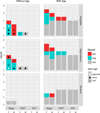Puberty and the human brain: Insights into adolescent development
- PMID: 29972766
- PMCID: PMC6234123
- DOI: 10.1016/j.neubiorev.2018.06.004
Puberty and the human brain: Insights into adolescent development
Abstract
Alongside the exponential flourish of research on age-related trajectories of human brain development during childhood and adolescence in the past two decades, there has been an increase in the body of work examining the association between pubertal development and brain maturation. This review systematically examines empirical research on puberty-related structural and functional brain development in humans, with the aim of identifying convergent patterns of associations. We emphasize longitudinal studies, and discuss pervasive but oft-overlooked methodological issues that may be contributing to inconsistent findings and hindering progress (e.g., conflating distinct pubertal indices and different measurement instruments). We also briefly evaluate support for prominent models of adolescent neurodevelopment that hypothesize puberty-related changes in brain regions involved in affective and motivational processes. For the field to progress, replication studies are needed to help resolve current inconsistencies and gain a clearer understanding of pubertal associations with brain development in humans, knowledge that is crucial to make sense of the changes in psychosocial functioning, risk behavior, and mental health during adolescence.
Keywords: Adolescence; Brain development; Functional MRI; Hormones; Puberty; Structural MRI.
Copyright © 2018 Elsevier Ltd. All rights reserved.
Conflict of interest statement
Declarations of interest: none
Figures





Similar articles
-
The importance of puberty for adolescent development: conceptualization and measurement.Adv Child Dev Behav. 2015;48:53-92. doi: 10.1016/bs.acdb.2014.11.002. Epub 2015 Jan 22. Adv Child Dev Behav. 2015. PMID: 25735941 Review.
-
Understanding the Role of Puberty in Structural and Functional Development of the Adolescent Brain.J Res Adolesc. 2019 Mar;29(1):32-53. doi: 10.1111/jora.12408. J Res Adolesc. 2019. PMID: 30869842 Review.
-
Neural systems underlying reward cue processing in early adolescence: The role of puberty and pubertal hormones.Psychoneuroendocrinology. 2019 Apr;102:281-291. doi: 10.1016/j.psyneuen.2018.12.016. Epub 2018 Dec 13. Psychoneuroendocrinology. 2019. PMID: 30639923 Free PMC article.
-
Pubertal hormones organize the adolescent brain and behavior.Front Neuroendocrinol. 2005 Oct-Dec;26(3-4):163-74. doi: 10.1016/j.yfrne.2005.10.003. Epub 2005 Nov 23. Front Neuroendocrinol. 2005. PMID: 16309736 Review.
-
Impact of socio-emotional context, brain development, and pubertal maturation on adolescent risk-taking.Horm Behav. 2013 Jul;64(2):323-32. doi: 10.1016/j.yhbeh.2013.03.006. Horm Behav. 2013. PMID: 23998675 Free PMC article. Review.
Cited by
-
Voluntary wheel running exercise rescues behaviorally-evoked acetylcholine efflux in the medial prefrontal cortex and epigenetic changes in ChAT genes following adolescent intermittent ethanol exposure.PLoS One. 2024 Oct 22;19(10):e0311405. doi: 10.1371/journal.pone.0311405. eCollection 2024. PLoS One. 2024. PMID: 39436939 Free PMC article.
-
Effects of Congenital Adrenal Hyperplasia (CAH) and Biological Sex on Brain Size.Anatomia. 2024 Sep;3(3):155-162. doi: 10.3390/anatomia3030012. Epub 2024 Jul 18. Anatomia. 2024. PMID: 39391581
-
Early Life Trauma, Emotion Dysregulation and Hormonal Sensitivity Across Female Reproductive Life Events.Curr Psychiatry Rep. 2024 Oct;26(10):530-542. doi: 10.1007/s11920-024-01527-y. Epub 2024 Aug 27. Curr Psychiatry Rep. 2024. PMID: 39187611 Review.
-
MRI signatures of cortical microstructure in human development align with oligodendrocyte cell-type expression.bioRxiv [Preprint]. 2024 Jul 30:2024.07.30.605934. doi: 10.1101/2024.07.30.605934. bioRxiv. 2024. PMID: 39131383 Free PMC article. Preprint.
-
Revisiting adolescence as a sensitive period for sociocultural processing.Neurosci Biobehav Rev. 2024 Sep;164:105820. doi: 10.1016/j.neubiorev.2024.105820. Epub 2024 Jul 18. Neurosci Biobehav Rev. 2024. PMID: 39032845 Review.
References
-
- Abdelgadir SE, Roselli CE, Choate JV, Resko JA, 1999. Androgen receptor messenger ribonucleic acid in brains and pituitaries of male rhesus monkeys: studies on distribution, hormonal control, and relationship to luteinizing hormone secretion. Biol. Reprod 60, 1251–1256. - PubMed
Publication types
MeSH terms
Grants and funding
LinkOut - more resources
Full Text Sources
Other Literature Sources
Medical
Miscellaneous

